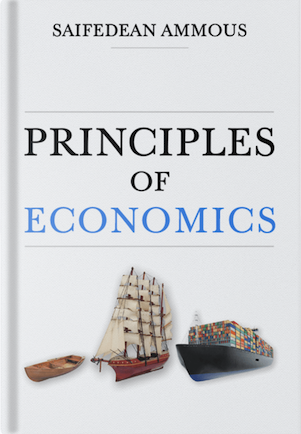This book is written by the author of The Bitcoin Standard, Saifedean Ammous, an internationally best-selling economist and author. He gives lots of thought provoking ideas and examples with data how human civilization has been moving forward with money which is the most important tool of our civilization. Its a University level textbook offering a comprehensive, engaging and easy to read overview of the field of economics.
Every chapters of this book are super-interesting read. Once you start to read, you cant stop before you finish at least that chapter. Its an overview of the Economy, its fundamentals, Market and how our civilization has economized human time and action to come to this date. There is no doubt we will do the same moving forward. The content is largely based on Austrian economist like Menger, Mises, Rothbard and Hayek.
What is Money?
I have been searching an answer to this question for quite some time. This book has given very interesting perspective on definition of money. First of all, money is not a social construct. Throughout the history, the commodity with the highest stock-to-flow ratio has become the widely adopted and trusted currency. Money is the good with the least diminishing marginal utility. Unsound money naturally promotes low time preference as there is reduction in purchasing power of any currency, people reduce saving and increase borrowing and immediate consumption. This lowers the productivity and ultimately leads to moral failings, destructive behaviors and harms society as a whole. Ultimately it sucks away the accountability for government failures and allows them to fail without any responsibility. So what is sound money? This will be the most important question of our generation.
I want you to read whole book because it is so informative and engaging that I cant summarize the idea in this blog alone. But will include the part of the chapter that I found very helpful in understanding the current state of World economy.
Water Diamond Paradox
Value is nothing inherent in goods, no property of them, nor an independent thing existing by itself. It is a judgement economizing men make about the importance of the goods at their disposal for the maintenance of their lives and well-being. Hence value does not exist outside the consciousness of men. – Carl Menger
How could economists explain that water, which was essential for human life, was usually very cheap, if not free, whereas diamonds, which are luxury goods that serve no essential purpose for humans, are very expensive? If value really is subjective, then why do people attach so much value to trivial things they do not need, like diamonds, while attaching only little value to essential goods like water? Would this not fit more with a labor theory of value, which would postulate that diamonds are more valuable because they involve more labor in their production?
Market value does not pertain to some inherent property of the good or to the value that all of its stockpiles afford us; it is based on the least important of the satisfactions the good meets. Since drinking water is usually available in the large quantities wherever humans are settled, it therefore, follows that the most pressing needs of water are already met, and that market choices are being made over units meeting far less pressing needs. A man stranded in a desert who has not had a sip of water for days would be willing to pay a far higher price for the first unit of water than the first unit of diamond, as water would be the difference between life and death for him.
It is therefore, inaccurate to say that diamonds are more valuable than water. The water-diamond paradox illustrates the importance of individual circumstances to the assessment of subjective value. In situations where water is plentiful and diamonds are scarce, water going to its least valuable uses is less valuable than diamonds, whose scarcity ensures that their least valuable uses still remain highly valuable. In situations in which water is scarce enough that the marginal unit will be deployed to satisfy the need for survival, water would undoubtedly be more valuable than diamonds.
Time
Man is subject to the passing of time. He comes into existence, grows, becomes old and passes away. This is why our time here is so scarce. He must economize it as he economizes other scarce factors.
– Ludwig Von Mises
Time is the ultimate resource and human action happens across time. All economic decisions take place across time and human production requires time. Man’s time on earth is scarce which gives his life enormous value. We cannot buy back the time we spent on something. This is why time is an unique economic good. Human time is the ultimate resource and the only money that is invaluable. Therefore economizing time is the ultimate economizing action. Only the scarcity of the time is what forces us to choose between the economic goods creating the scarcity.
When a child is born, his time here on earth is uncertain. It might be as brief as 1 hour, or it could last a whole century. Nobody knows how long he’ll live but everyone soon realizes we won’t live forever. With that realization and maturity, humans economize time. Scarcity of human time increases substantially as we age. Human time is the ultimate resource as it can produce unlimited resources through time.
The fact that our time is scarce, means we cannot engage in all activities at all times. We must choose to spend our ultimate scarce resource. The inevitability of Death and finitude of Time hence its scarcity, necessitates a constant accounting for opportunity cost. From that comes all of man’s economic thinking and actions. All human actions consume time, therefore come at the cost of foregone actions.
These are the thought provoking words from the book which are so fascinating to read and we cant agree more on this. The author has also written about the Oppotunity Cost, Material Abundance which I found very interesting because he has provided tons of data which shows how misguided people are with all these current Environment related information being fed by the mainstream media. Below are some data he has included in the book regarding the abundance of material here on earth.
While material goods are technically scarce on earth, the absolute quantities of them are far beyond our ability to exploit. The amount of material is what does not make them scarce, the most scarce is the time required to produce or mint those goods.
World’s Population
1950 – 2.5 Billion people
1990 – 5.3 Billion people
Global GDP measured in 2011 Dollars
1950 – $9.25 Trillions
1990 – $47.04 Trillions
In 40 year period, population grew by a multiple of 2.13 in which human production grew 5 fold. The proven reserves of most metal grew higher than the population growth. Similarly,
Lead by 3 fold
Zin by 4.21 fold
Copper by 5.66 fold
Iron ore by 8.27 fold
Oil by 13.1 fold
Phosphate by 14 fold
Bauxite by 16.6 fold
The measure of proven reserves does not serve as a reasonable measure of the Earth’s total resources, but as a measure of the amount of effort human put into the search and exploration of resources.
Earth’s surface area is 510.1 million km².
Total area used for mining between the years 2000 and 2017 was estimated at 57.255 km² → 0.011%.
For perspective, if Earth was the size of a soccer field, the world’s mines would be roughly the size of a small desk.
Diameter of Earth is 12,742 km.
The deepest mine in the world, Mponeng gold mine near Johannesburg is 3.16~3.84km → 0.024% ~ 0.03% of Earth’s diameter.
For perspective, if Earth was a ball with a diameter of 1 meter, the deepest hole ever dug in its crust would be 0.027cm deep (thickness of the three papers measured together).
All of the resources humanity has used in millennia of consumption and exploitation are but a tiny fraction of the bounty available in the superficial 0.027% of Earth’s diameter.
For perspective, if the Earth’s volume was that of an Olympic swimming pool, all the world’s mines would be roughly the size of half a cup.
The world’s population would need to double for us to be digging into one cup’s worth of an Olympic swimming pool. Even with enormous growth in the world’s population, we will barely scratch the surface of our vast, bountiful planet.
What we really value are not resources, but economic goods made from resources. That is what requires time, and all that is what is scarce. That is the scarcity from which all other scarcities originate. The raw material is everywhere around us, but the time to produce economic goods from it is scarce.
WTF happened in 1971?
You can see for yourself here.
After U.S. President Richard Nixon suspended the convertibility of the U.S. dollar into gold in 1971, all prices began an inexorable rise, a trend that continues to this day. For people in the 1970s accustomed to relatively stable prices under the gold standard, these price rises seemed like a sign of an economic apocalypse, as it gave the impression that all our precious resources were running out.
There are tons of information like these in the book, which is why I recommend you to read the whole book. The author has written on Economy, Labor, Production, Time Preference, Property, Ownership, Capital, Technology, Software, Energy, Money, Market, Credit, Civilization and so much more.
Hope you enjoyed this and see you on next one.
You can buy me a coffee if you enjoyed 😉
BTC Address:
bc1q0859dv58ppwcvraq48et98thamkqlm2j24dult



4 replies on “Principles of Economics”
I believe there are many more pleasurable opportunities ahead for individuals that looked at your site.
[…] Taxes are rising and will continue to do so. The most powerful governments in the world can’t even solve their problem of homelessness, yet they are boasting that they can change earth’s temperature, if you pay more taxes. Pretty funny and laughable. You can check more about history of taxes in Daylight Robbery and if you want to know about economics, you can check out The Principles of Economics. […]
I know this web page presents quality depending articles
and additional stuff, is there any other web page which provides such data in quality?
We are a group of volunteers and opening a new scheme in our community.
Your site offered us with helpful info to work on. You have
performed a formidable activity and our entire community shall be grateful to you.